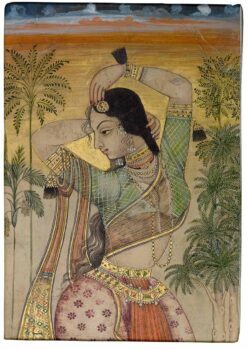Please keep the other posts on topic. Use this for talking about whatever you want to talk about.
Month: June 2019
What The All-Father Means
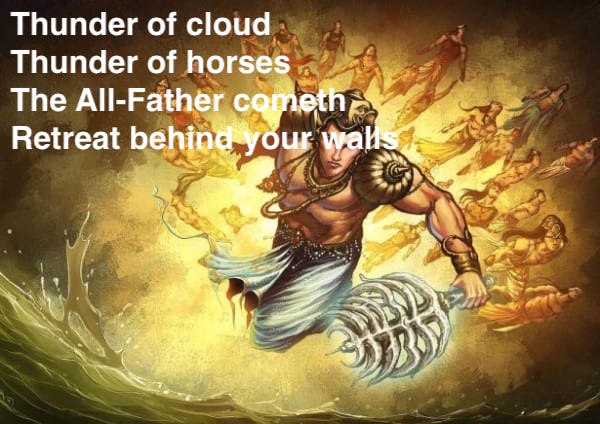
Readers of this weblog may sometimes notice that I break out in pompous and self-important declarations of being a “scion of the All-Father.” This is basically a joke. But, it’s a joke that draws from a legitimate basis of science and mythology. The “All-Father” is another name for Odin. I’m really talking about Indra, who is probably more like Thor. And obviously, Norse paganism is only distantly related to the mythology of the Indo-Aryans. As someone more familiar with the lineaments of Northern European mythology than Indian, of course, it’s easier for me to draw on the motifs of the former to relate to the latter.

The scientific component has to do with R1a. Specifically, R1a1a, defined by the M17 mutation (discovered by my boss at my day-job 20 years ago). There are two very closely related “clades,” that is, families of pedigrees, of this Y chromosomal lineage, passed from father to son. One of them defines mostly European R1a1a, Eastern Europeans, and to a lesser extent Western Europeans. Another branch is found mostly in Central and South Asia.
When I first saw this distribution around the year 2000 it left me scratching my head. Of course, I knew about the Indo-European languages. But I had always assumed that the demographic impact of the original Indo-Europeans was relatively marginal. And yet this Y chromosome was found at frequencies in the 10-50% range across vast swaths of Eurasia.
Much of the 2000s was spent on arguments as to whether R1a was indigenous to South Asia or to Central Eurasia. Ultimately these arguments were not resolvable due to limitations of the data. To calibrate dates and diversity researchers relied on microsatellites, which are useful due to their high mutation rates, but also erratic for the same reason (not only were confidence intervals wide, some of the assumptions of the model parameters were guesses).
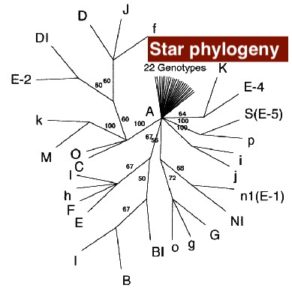 In the early 2010s, whole-genome sequences of Y chromosomes came online. It became very clear that the most common R1a1a lineages exhibited the “star phylogeny.” Demographically, what this means is that men carrying this lineage underwent very rapid population expansion for a short period of time. So rapid that a “father” lineage would give rise to numerous “son” lineages one mutational step away
In the early 2010s, whole-genome sequences of Y chromosomes came online. It became very clear that the most common R1a1a lineages exhibited the “star phylogeny.” Demographically, what this means is that men carrying this lineage underwent very rapid population expansion for a short period of time. So rapid that a “father” lineage would give rise to numerous “son” lineages one mutational step away
You can see in the figure that node “A” has given rise to a “star phylogeny.” A large number of individuals are one mutational step away from that genotype. A more normal phylogeny would produce a complex structured tree which accrues mutations across the various branches gradually.
In the South Asian context, a paper from 2004, Independent origins of Indian caste and tribal paternal lineages, introduced a result which prefigured what we now know:
Analyses of molecular variance also suggest that caste groups are more homogeneous for Y chromosome variation than tribal groups, since the variance among caste groups (sampled from all over India) is 3-fold less than that observed among tribal groups and 2-fold less than that observed among all Indian populations grouped together (Table 3). Moreover, if only north caste groups are considered, the variance among populations is not significantly different from zero (Table 3), indicating that spread over the Indian subcontinent although they are located up to ∼1500 km away from each other, these populations have highly homogeneous Y chromosome compositions.
The implications of the lack of structure of R1a on the Indo-Gangetic plain is always something that struck me. It suggested that the paternal lineages only recently expanded since they didn’ have time to build up distinct regional mutations. In contrast, the adivasi populations had a wider distribution of Y chromosomal haplogroups, and they exhibit a lot deeper diverged lineages.
Which brings me to the personal angle. In the spring of 2010, I did my first personal genomic test. I got my Y and mtDNA results back first. It turned out my Y was R1a1a, and my mtDNA was U2b. I was surprised by both. Eastern Bengali has the highest fraction of mtDNA macrohaplogroup M in the world. R1a1a was less surprising. But, it was very strange to have a concrete, personal, connection to this lineage which had been on my mind for a decade or so.
My funny attachment to my haplogroup is probably a function of my upbringing. Growing up as brown in the United States, I wasn’t exposed to Indian culture, nor was I well versed in the details of South Asian communalism. My family is pretty conventional in being upper-middle-class Bengali Muslims, so there is not a jati identity or anything like that I could identify with (and though my parents are Muslim, they are not extremely so, therefore religious identity was a background and not foreground variable). When I looked at my overall genome in 2010 it was clear I didn’t have the “runs of homozygosity” that characterize many people from South Asian backgrounds who come from endogamous communities. I know some of my ancestors were Kayasthas, and my father has some Brahmin ancestry, but the most distinctive thing about me in hindsight is I’m a typical east Bengali with more than a usual dollop of East Asian ancestry (my family is from Comilla).
My Y chromosomal haplogroup, in contrast, is something clear, distinct, and precise. It is an anchor, something which I use to channel my preoccupations and concerns. I don’t have Omar’s Gujar tribal ancestry, or Zach’s Muhajir/Persian origins. I’m just a brown American whose parents did not instill him a patriotism about the “motherland” (Bangladesh), because they themselves didn’t even live a decade in that nation. Though there is a spectrum, it is clear that many South Asian Americans are less “coconut” than I am, and are attuned to fine differences of status, origin, and background. Growing up around only white people my identity was racialized, not ethnicized.
I have never felt superior or inferior to any community or ethnicity of South Asian because I never belonged to any community, have weak ethnic identity, and don’t believe in any religion. The religious prejudices I do have are probably Anglo-Protestant ones against Catholicism, because of the implicit assumptions and background facts of America’s Whig culture.
What R1a1a symbolizes to me is that I have a concrete connection to a semi-historical phenomenon between the end of prehistory and before the written word, which we have not grasped or understood very well. Though it is true R1a1a is found at higher concentrations in “upper castes,” as well as in the north and west of the subcontinent, and among Indo-Aryan speakers, the reality is it is found in almost every community in South Asia (the main exception being among Tibeto-Burmans and Munda). There are many communities, such as Chenchus, which have very little steppe ancestry but retain a substantial proportion of R1a1a.
For obvious reasons this haplogroup is associated with Indo-Aryans (the earliest find of R1a1a-Z93 is from the Bronze Age Volga Srubna culture), but its reach is far beyond current areas of Indo-Aryan speech. Its ubiquity is a testament to a broader South Asia cultural matrix that emerged in the centuries after 1500 BC, from north to south.
This is of course not a moral judgment. The expansion of this paternal lineage at the expense of others likely occurred through a process of aggression and social exclusion. This is nothing to be proud of…or ashamed of. It’s just a description.
Indian Female Academics of the Left
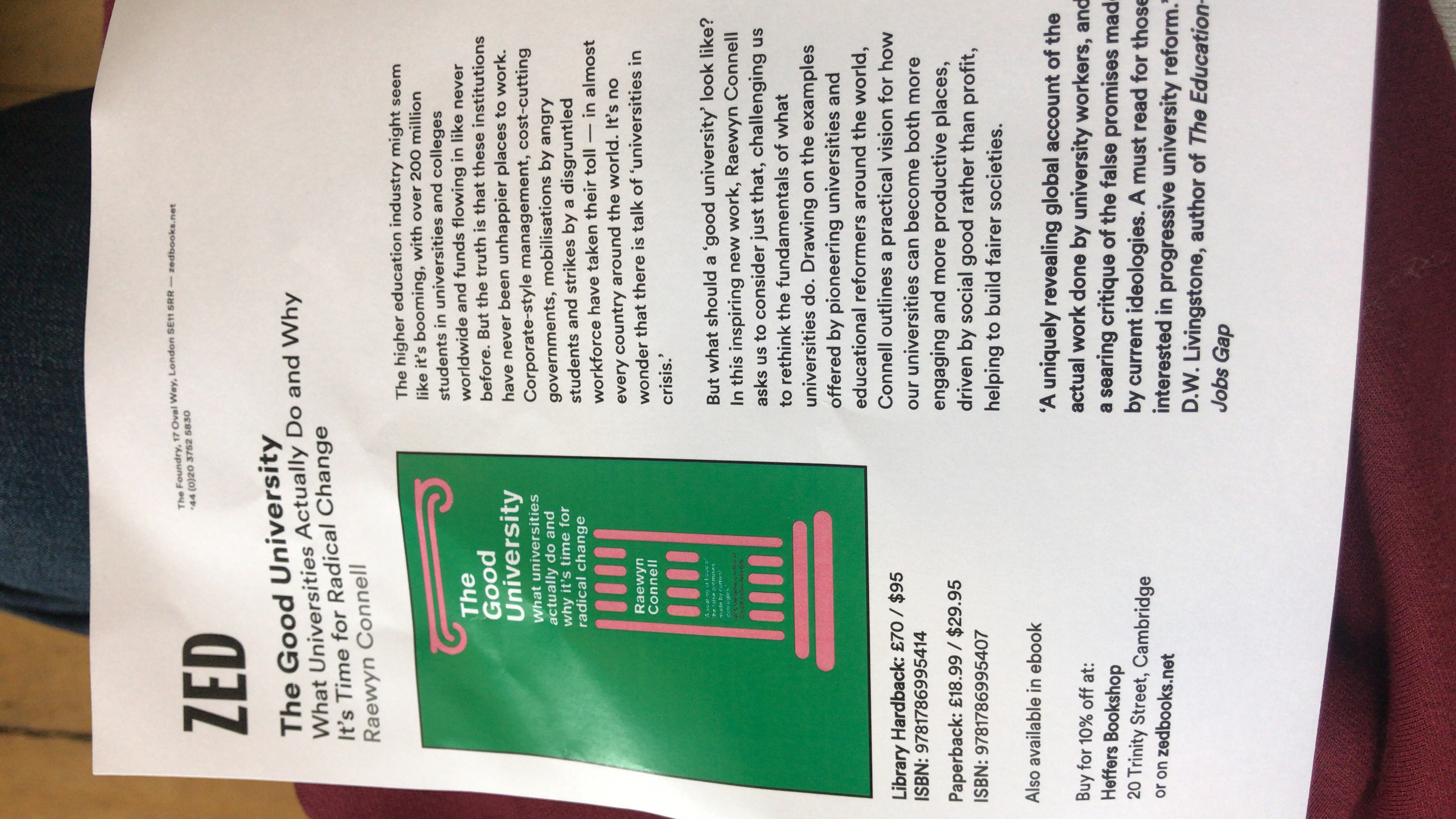
I’m at this talk, which touched on decolonisation and other such left-liberal ideology.
I’m quite privileged to be attending lectures and seminars at one of the best Universities in the world (even if it’s been coasting on its brand name).
The speaker in question is a Professor Emerita. She’s Trans but white. I find the discourse on the left increasingly driven by white LGTB+ activists. She is interviewed by a Indian lady (Reader level So tenure track Prof) and introduced by another Indian Lady Lecturer.
I’m noticing a few trends:
(1.) Indians in postgraduate humanities are acolytes of Arundhati Roy. They’re sort of blending into the global liberal intellectual circles in a way that Muslims don’t.
(2.) Left-liberal Indians have become entirely de-Hindufied in a way that left-liberal Muslims simply haven’t. So while there is an invisible barrier for Muslims to fully embrace the entire ideology (more likely than not they’ll have some sort of belief barrier) there isn’t one for Indians.
(3.) Postgraduate Indian women in the Humanities are at the vanguard of social action and use their ambiguous racial status to float between black & white space.
(5.) Postgraduate Indians in STEM are rightish, which is no really surprise and in line with trends.
(6.) Being vocally right is social suicide in the “coloured circles.” It’s suspected I have profoundHigh Tory views but I downplay it to my Social Justice Ghazi alter ego (I am a Magian after all) and join the activists IRL. My concession is that I try to be intellectually consistent and avoid Munafiqeenism.
(7.) the South Asia centre has only one coloured faculty member (albeit the director) the other 7 are all white. It begs the questions what should (or should there) be a racial balance for ethnic studies?
(8.) People in Humanities love their jargon; maybe it’s because their subjects aren’t as intense as STEM?
BP Podcast episode 48: Hitchhikers Guide to Hindustan
Another BP Podcast is up. You can listen on Libsyn, iTunes, Spotify, and Stitcher. Probably the easiest way to keep up the podcast since we don’t have a regular schedule is to subscribe at one of the links above.

This week Xerxes speaks to Rajat Ubhaykar about his epic trips around the Indian terrain. A few inadvertent comments by Xerxes sparked off this massive comment thread so click on the BroCast to find out what it’s all about.
You can also support the podcast as a patron (the primary benefit now is that you get the podcasts considerably earlier than everyone else…). Would appreciate more positive reviews.
The price of Unity for India’s Dravidians
My title is somewhat controversial but it’s based on a passing thought.
I was seeing Drew Binsky’s video on the Afghani diaspora in Hamburg and I found it interesting that Afghanistan’s population is only 35mm (I could have sworn it was 20mm around the turn of the century).
Even though Afghanistan has a relatively tiny population, compared to many Indian states, its influence on world affairs dwarfs them and approaches Indo-Pak.
For the 4 Dravidian states; their sub-nationalism disappears in the global stage in the face of Indian nationalism.
This isn’t to stir discord; it’s a thing of wonder that 90%+ of the world’s Hindu population is in a single state. In fact if 90% of the world’s Muslim population were in a similarly federalised state; it would be so much better (even just the contiguous bits).
However I wonder if the more exotic Indian minorities do not feel that their presence in the global stage is somewhat marred. Sovereignty, while disruptive, has a charm all of its own.
After a people who aren’t used to their nation will see that nation dwindle away due to apathy.
Many will impute that I support independence movements or further political sovereignty; far from it. But I was thinking of the British Lions model and the world of sport.
There are times when Britain competes as one (in the Olympics) and at other times devolves into the Constituent nations. In fact in most sports Ireland competes as an island (Ulster joins Ireland rather than any of the other nations) even though the political atmosphere is so messy.
Aside from IPL (and the huge shadow cricket casts on the subcontinent); it would be nice to have some sort of South Asian game or cultural event where linguistic (sub)nationalism is given priority. It would be perhaps alleviate the intense communalism of South Asia’s political setup and also provide context to the “young states” that there are some very old “nations” in South Asia, which precede them.
Maybe it’ll be a bit tricky with Punjabis, Pathans, Baloch teaming up across their various borders or even Tamils for that matter but it might also help *mature* identities as well.
I’m a trustee of a Theatre company in Cambridge and I really enjoyed the definition of a “minority”; one who self-identifies as such. In many ways that’s how I would categorise a language family/nation. Languages are also a form of subjective identity rather than just objective reality.
A language is a dialect with an army..
Live Blogging: White noise, séances & colonial linguistics
As a side note, it will probably help if I create a category/tag for all these lectures.
Grierson’s gramophone recordings of Indian languages & dialects by Professor Javed Majeed
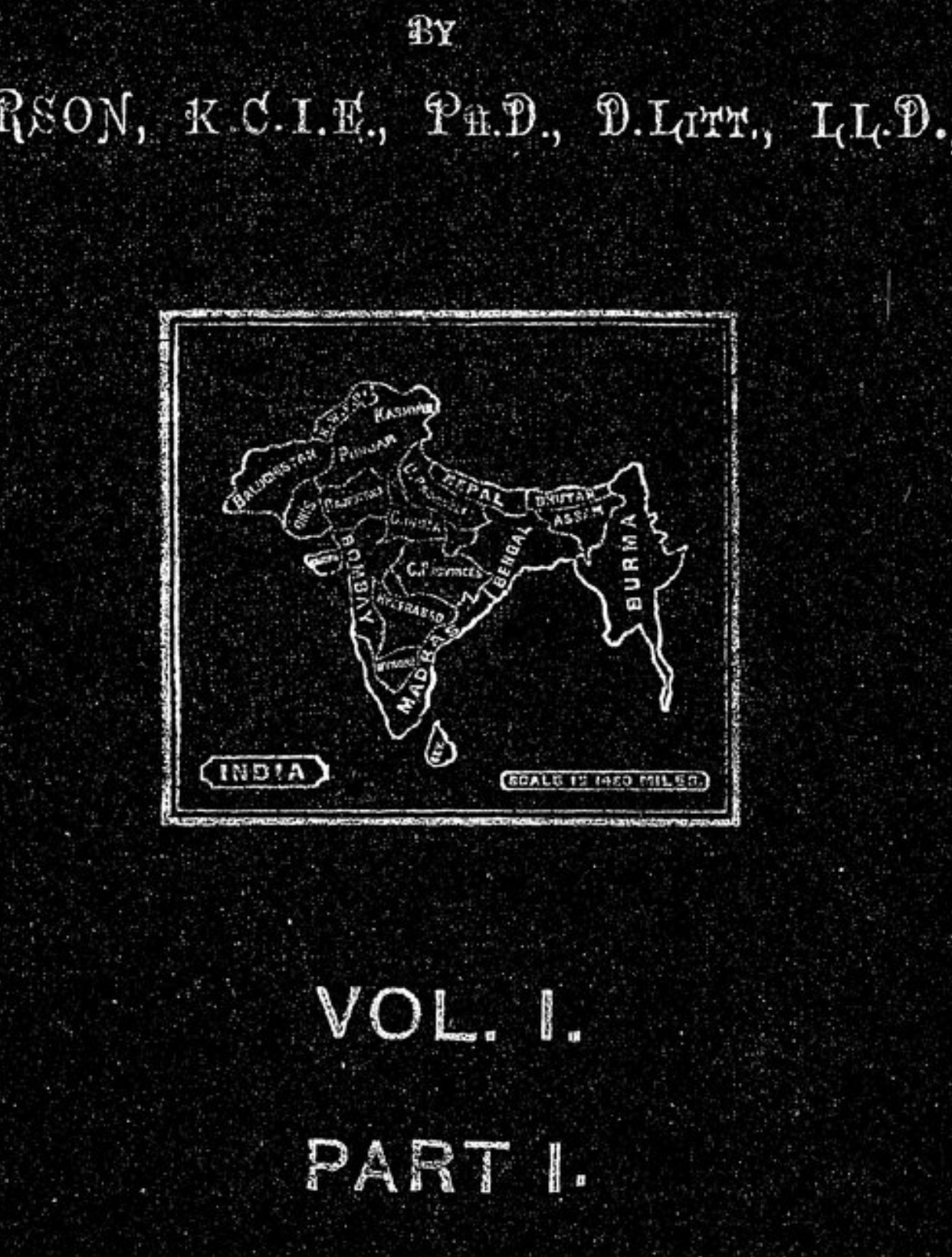
Continue reading Live Blogging: White noise, séances & colonial linguistics
The Harilals of Hong Kong
Such an amazing video; the joint family done well by the famous Harilals of Hong Kong (they own the Pearl Continental building). Even though I would swap it round and send the sons as further afield as possible (like the Rothschilds) and keep the daughters (if I had a daughter I’d want her to go into STEM subjects; the tougher the better).
I’ve met one of the Harilals daughter-in-law at a wedding; she was fun-loving and rather incandescent, she certainly stood out.
I do find the whole nuclear family setup to be so much unnecessary grunt work.
These sort of Diaspora Baniya families (I think Bhaibands, Vidhi’s caste, are originally Punjabi Khatri who moved southward towards Sindh) are going to keep the candle of Hinduism alive against assimilation.
Samosas vs. Pakoras
I know the comments about Islamicate Samosas vs. Indigenous Pakoras was made in jest however what is interesting that the “core Desi” food is carbo-hydrate heavy.
At least Samosa has some protein in comparison to the Pakora, which is basically fried batter (delicious as it is).
I tend to prefer Desi Khans above all else however I have actually taken to eating a steak or another grilled meat just to complement my meal.
This isn’t to revisit older tropes about vegetarian Hindus and meat-eating Muslims but the only protein source I can think of is daal and milk products.
A Pakistani on Instagram once remarked that his favourite cuisine is Arabic food. I immediately took offence since Mughlai cuisine is so much more complex. But his reasoning did make sense that in the balance of health and taste Arabic food was a clear winner.
Interestingly one of our young relatives (at the age of 6) has decided to go completely vegetarian. The family are completely Westernised and meat-eating but the young chap refuses to eat any meat (he wants to give up jelly beans because it has animal products).
It’s gotten to the point that he scolded his mum for buying a leather bag because it’s made from animal hide and while on a car journey he started to meditate. He’s naturally very rambunctious and mischievous but it’s just an interesting exercise in “spontaneous vegetarianism” (we were all eating lamb chops and chicken but he was just sticking to daal).
His mother had to pack all these “mithai”, full of ghee, just to make sure that he met his calorific intake. In a way Indian food is catered to meet calorific loads rather than nutritional values. Nomadic food on the other is just an exercise in how to cook different types of meat. Of course these cuisines are pared with occupational types and we aren’t nomads & farmers anymore.
Sajid Javid finally *owns* his Pakistaniness
This is a very powerful video – regardless of one’s politics. It’s such a powerful evocation of the Immigration and Asian experience in this country. The *hidden* history so to speak.
Hands down the best video of the Tory leadership election so far. 👏 to those advisers who always wanted him to campaign like this and to his new comms team for delivering on it https://t.co/CwYltajif3
— Tim Shipman (@ShippersUnbound) June 11, 2019
Ordinarily I stayed away from supporting Sajid since he seems so white-washed (at Conference he made an awful Punjabi-Welsh joke) but finally I felt that he owned up to his Pakistaniat, which moved me.
Between Marx and the mullah
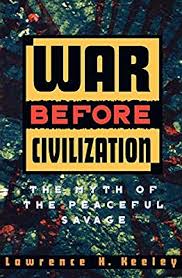 There is a lot of talk on this weblog about deaths in premodern conflicts. I want to clarify a few points, at least from my perspective.
There is a lot of talk on this weblog about deaths in premodern conflicts. I want to clarify a few points, at least from my perspective.
Both ancient DNA and conventional history and archaeology indicate that massive population turnovers occurred in the past. If you read a book like Genghis Khan: His Conquests, His Empire, His Legacy, you note that there is plenty of record of massacres and killings in targeted fashion during the Mongol expansion. The chaos and demographic collapse induced by the Mongols have been implicated in reforestation across vast swaths of Central Eurasia (which may then have produced climate change!).
We can also look to the deep past, and the more recent past. Latin America is characterized by incredible admixture between people of disparate ancestries. This is due in large part to 1) demographic collapse on the part of native peoples 2) migration of settlers from Iberia 3) transportation of slaves from Africa.
The evidence from Europe and South Asia is also strongly suggestive of massive population replacements. Depending on your model parameters about 50-75% of the ancestors of modern Northern Europeans who were alive 5,000 years ago had descendants who were intrusive to Northern Europe. Another way to say this is that 50-75% of the ancestors of modern Danes did not live in Denmark or nearby regions 5,000 years ago. A similar number for South Asia seems to be in the 10-30% range (again, depends on your model parameters).
This elicits the question: was there genocide?
The evidence from Latin America is clear. Though there was targeted genocide on the part of the Iberian conquerors, on the whole, the deaths were mostly due to the introduction of Eurasian diseases that resulted in a cascade of consequences which resulted in famine (the Black Legend is propaganda which has influenced our modern perceptions). When a human population lives on the Malthusian margin, small perturbations can result in death due to starvation. In the case of Latin America, it is known that incapacitation of a large enough proportion of prime-age adults due to illness resulted in famine, as crops were not planted or harvested in quantities necessary to sustain villages.
In other words, population collapse was a function of reduction in labor inputs into agriculture.
And, the reality is that the Iberian conquerors, who were often younger sons of aristocratic lineages, were not inclined to engage in mass-slaughter due to the reality of their aspiration of becoming rentiers. The importation of African slaves was to a great extent a direct consequence of shortages of exploitable labor (along with the humanitarian concerns of enslaving natives). Contrast this to the situation in the Phillippines or India, where Asian peoples provided resources to support leisure-seeking European elites.
A second fact is that premodern states were not capable of the sort of coordinated genocide that has been seen in the 20th-century. They lacked the weaponry, information technology, and organizational capacity to be particularly efficient. I don’t think it’s a coincidence that the coordinated genocides against Christian groups in the Ottoman and post-Ottoman realm occurred in the modern period (Armenians and Assyrians). The older Ottoman state was neither efficient enough nor did it have the means, to engage in total exterminationism (I also believe that 19th-century European-style nationalism probably made exterminationist feelings more ‘justified’ as well).
Probably the best premodern instance of ethnic cleansing we have on record is the Spanish expulsion of the Moriscos, which occurred on the basis of presumed blood lineage, not belief (e.g., many sincere Christian Moriscos were expelled as well!). But, that effort was incomplete and patchy, effective in some areas, totally ineffective in others, and haphazard in the criteria utilized (e.g., many people with Morisco ancestry were not expelled, while families which had been sincere Christians for generations were expelled).
Which brings me back to the earlier cases. What happened in Europe and India to induce population change?
There are several things going on in my opinion. First, not all late Neolithic/early Bronze Age societies had developed an ideology of elite exploitation to the level that we’d take for granted in the modern world. By this, I mean that the leaders of these agro-pastoralist societies may not have viewed farmers of different ethnicities as potential subjects, and so wealth. In conflicts between hunter-gatherer populations often warfare results in very high mortality rates, with young children and young women of the losers assimilated into the winners. There was no ideology of group assimilation for young men into an alien population, and in societies without specialized professions and economic systems, these men might not be seen as valuable in any sense except as consumption slaves (servants for powerful people, not economic producers).
In other words, conflicts between primitive societies can be thought of as “animal conflicts,” where two groups fight over resources and don’t view the losers of the other group as resources. In contrast, societies over the past few thousand years have tended to see the defeat of the enemy as a potential for elites to accrue new subjects from which they can extract rents. This was one of the arguments made to Genghis Khan by one of his Khitai advisors as to why he should not clear the land of northern China of people so as to create pastures for horses and sheep. People were more valuable than horses and sheep. He would be richer with more people.
Of course, these are people with spears (and later swords). I don’t think that most of the demographic collapse was due to direct killing. Rather, people living on the Malthusian margin, especially the sort of late Neolithic farming that was likely marginal in Northern Europe, were likely subject to the same famine dynamics as occurred in the New World. The IVC zone in South Asia was clearly more advanced, but it too many have been relatively fragile in comparison to the agricultural regimes of later South Asian societies.
The final issue is looping back to Muslims. Did they commit genocide? Did they exterminate the local populations? Probably. But, 95-99% of the ancestry of South Asian Muslims is the same as that of South Asian Hindus of the same region. Unlike the incursion of Indo-Aryans, the arrival of Muslims, mostly Turks, Afghans, and Persians did not have a major demographic perturbation in a direct sense (indirectly, technology and organizational skills introduced by Muslim elites may have resulted in disparate demographic growth of different regions in South Asia; e.g., Eaton’s argument for the expansion into eastern Bengal).
Additionally, Islam as a dominant ideology developed during the high-tide of rent-seeking elites. Though Muhammad’s status as a merchant meant that the religion was never constitutively anti-mercantile, conquest elites invariably aimed to extract wealth out of conquered populations. Arguably, the development of Islam is a direct consequence of how lightly Christianized Arab conquest elites developing an ideology which justified their extraction of rents (“protection taxes”) from conquered populations, as well as maintaining their separateness and distinctness.
In the Indian context, many will point out that Islamic chroniclers note the despoilation and slaughter upon the local population. I would suggest that one be cautious about the propagandistic nature of ancient conflict and war (this begins with the Battle of Kadesh). Ancient chroniclers seem to have exaggerated numbers and effectiveness routinely. At least in the early modern period, most casualties due to battlefield injuries were the consequence of infection, not immediate trauma. Similarly, I suspect that the depopulation of an invaded region was more likely a consequence of the disruption of local social fabrics more than direct killing with arrows, swords, and spears (killing people expends a lot of energy and is risky).
Because of the nature of this blog, of course, this post ends with the arrival of Muslims to India. The stupid and the disingenuous (or a mix of both) seem to fix on two extreme positions:
- Muslims arrived and ushered in an orgy of slaughter driven primarily by the motive of oppressing the kuffar
- Turks arrived in India, and like earlier invaders aimed to extract resources and dominate the location population
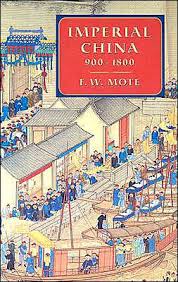 These caricatures serve ideologies but don’t describe reality. Both materialist and non-materialist motives need to be considered. The chroniclers of the arrival of self-conscious Muslim military forces to South Asia clearly wished to present it as an ideological and religious act. These were ghazis, just as far to the west, the Ottomans began as ghazis. But it is also impossible not to notice the family resemblance of Muslim Turks moving into South Asia in the centuries after 1000 A.D. with the invasions and conquest of China by Turkic, Mongolic and Tungusic peoples in the centuries after 1000 A.D.
These caricatures serve ideologies but don’t describe reality. Both materialist and non-materialist motives need to be considered. The chroniclers of the arrival of self-conscious Muslim military forces to South Asia clearly wished to present it as an ideological and religious act. These were ghazis, just as far to the west, the Ottomans began as ghazis. But it is also impossible not to notice the family resemblance of Muslim Turks moving into South Asia in the centuries after 1000 A.D. with the invasions and conquest of China by Turkic, Mongolic and Tungusic peoples in the centuries after 1000 A.D.
Not surprisingly, the Khitai, Jurchen, and Mongols, all made some ideological claims for their acts of aggression of conquest, often post facto and tenuously. The Khitai and Jurchen integrated themselves into the Han Chinese worldview and presented themselves more worthy stewards of the Mandate of Heaven than the Song rulers of China. The Mongols also did this, though perhaps even more foregrounded was their own peculiar ideology than their sky god had given the whole world to them to subjugate (the Mongol Yuan dynasty also gave special consideration to Tibetan Buddhism, which alienated their Han subjects).
But of course, we would notice that the major consequence of the Mongol Yuan dynasty was the transfer of resources from Han Chinese elites to arriviste Mongol elites. The overthrow of the Yuan resulted in the expulsion of the killing of many of these hated Mongol landlords. Ideological rationales were given, but the memories of Han elite dispossession were fresh.
 And yet despite the fig-leaf that ideology provides, differences may result from such distinctions. The Khitai and the Mongols were more punctilious is differentiating themselves from their Han subjects than the Jurchen. They maintained their separateness due to their reduced respect and veneration of Confucian norms. And, notably, the philo-Sinic Jurchen were assimilated into the Han to a far greater extent than the Khitai and the Mongols.
And yet despite the fig-leaf that ideology provides, differences may result from such distinctions. The Khitai and the Mongols were more punctilious is differentiating themselves from their Han subjects than the Jurchen. They maintained their separateness due to their reduced respect and veneration of Confucian norms. And, notably, the philo-Sinic Jurchen were assimilated into the Han to a far greater extent than the Khitai and the Mongols.
Similarly, in South Asia, the ideological distinctions between the rentier class of Turks and West Asian Muslims, and native Indians was sufficient for the absorptive process to halt. Synthesis occurred. But amalgamation did not proceed to completion. In David Cannadine’s Ornamentalism the author argues that the religious difference was also the key reason that the Indian elite, Muslim, Sikh, and Hindu, did not intermarry with the British gentry.
The various arcs of history cannot be easily defined by grade-school level Marxism, or internet Hindu level psychoanalysis. In all regions that self-conscious Muslim conquest elites established themselves, their sense of distinctness, superiority, and God-given right to rule are clear. But, all these groups, whether it be the slaving regimes of Arabs in East Africa, the Ottomans in the Balkans, and yes, Muslims in South Asia, exhibited a strong orientation toward pragmatic exploitation of the riches of the regions which they conquered.
Addendum: I’m going to delete stupid comments. This means if you leave a 2,000-word comment that’s stupid, it will be for naught.
